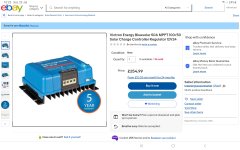not in your situation.
You can potentially mix 12V and 24V panels on the same controller when they are connected in series. So a 24V panel plus a 12V panel will create a 36V panel setup, just like you can have 3 12V panels in series to make a 36V array.
you cannot connect different voltages in Parallel without massively compromising the output, so that is never a practical option.
This shows the difference between 3 12V panels in Parallel vs 3 12V panels in series (which could, as mentioned, be a 12V + 24V Panel)
 seriesvsparallel
seriesvsparallel by
David, on Flickr
As an aside, you see the current on the series array is much lower than the parallel array.
But .... remember a "12V" panels voltage can be higher than 20V, and a "24V" panel can be higher than 40V.
The only way to combine your three panels (2 x 24V plus 1 x 12V) is in Series, and when you bear the PV voltages in mind, that makes the array >40V + >40V + >20V, so the total is over 100V and therefore you could not use the 100/50 controller in that setup.
What you COULD potentially do is get the 150/45 Controller instead. That is a 650W Controller, so above your total theoretical maximum of 620W on the 3 panels.
BUT ... and this is a very BIG BUT .... when you add the voltages together in a SERIES setup, the way the current works is you take the lowest current value of all the controllers as the maximum Input Current. So you will be effectively downgrading the 260W panels to more like 200W panels and you could in fact end up with LESS power overall by adding on the 100W panel, incredibly enough. If it were a 130W panel, then it would be a different story.
Your only real option is a different controller for the 100W panel.
As an example, I mentioned I am looking to add more panels onto my setup? These will be panels just a third the size, so the current is much lower than the existing one. My only option for that reason is to add them in Parallel (as they are all "12V" panels, that is fine).
But even then I am losing wattage from the bigger panels as the smaller panel also has a slightly lower max voltage (losing around 4W per 90W panel, so not massive enough to worry about in my case, but if it were say 20W or 30W per panel, it would be a different story).


